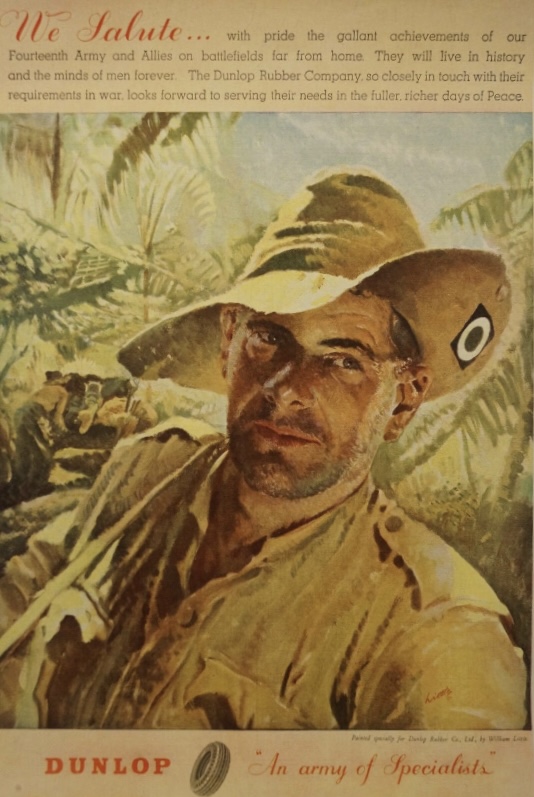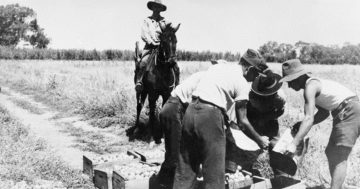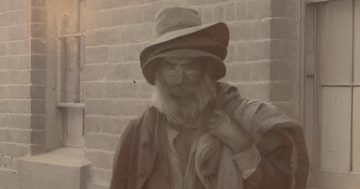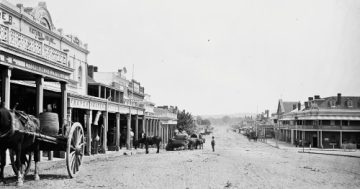
The Dunlop Factory Annual Christmas Party, 1947. Photo: WWDHS Sherry Morris Collection.
With Christmas Parties breaking out across the Riverina in the countdown to December 25, we thought we’d look back to the Ghost of Christmas past and a gone-but-not-forgotten manufacturing institution.
This fabulous photo from Christmas 1947 captures some of the many employees from Wagga’s Dunlop Factory that once stood on the corner of Murray and Forsyth Streets overlooking Wollundry Lagoon.
The organisation was known to look after the wellbeing of its staff with many sporting teams, regular picnics and social events and, of course, the very popular Christmas party.
Dunlop took over a government munitions factory during the latter stages of World War 2 and manufactured ‘jungle greens’ and weatherproof uniform items for Aussie troops in New Guinea.
According to a story in Wagga’s The Daily Advertiser in 1946, they began with a “staff of 10 girls on March 1, 1944” but had rapidly expanded over the next two years to employ 150 men and women with “room for 150 more operatives to work under ideal conditions”.

A wartime advertisement for Dunlop and the products made in Wagga Wagga. Photo: Dunlop Australia.
The decision to open a factory in Wagga followed a push from the Labor government to decentralise manufacturing.
“Through a £75,000 subsidiary, Dunlop Waterproofs Australia Pty Ltd, it is going to test out one of Labor’s pet theories by manufacturing waterproofed materials for the defence forces at Wagga,” declared an April 1944 story in the tabloid Smith’s Weekly.
“But the company isn’t placing too much of its own capital at stake in this experiment. It hasn’t bought the factory outright. It has merely taken a sublease from the Department of Supply and Development,” they warned.

Wagga’s Dunlop Factory in the 1960s and today. Photo: CSURA/Google Maps.
However, it seems that the gamble initially paid off for Dunlop, who remained in the Riverina for the next three decades and employed thousands of locals from across the region.
The Daily Advertiser praised the modern factory that had “its own hospital, kitchen, canteen, and restrooms. The factory has natural lighting and large electric fans and heaters provide for cooling the building in summer and heating it in Winter”.
“With the modern machines laid out in rows there is a rhythm between the hum of machines and the singing of the operatives,” the story continued.
“The factory has its own social club and publishes its own magazine.”
In 1948, a visiting state government minister declared that “Wagga has 33 per cent greater industrial efficiency than Sydney” and in 1949, the Advertiser reported that the former munitions factory “now manufactures men’s, women’s and children’s coats in rubber, and specially waterproofed fabric”.

Dunlop Weatherproofs Australia Pty Ltd in 1960 Photo: CSURA (Lennon Collection).
In its heyday, the Dunlop Weatherproof Factory was churning out a broad range of garments, including police uniforms and the ‘whites’ for the Davis Cup tennis team.
Despite its success, one of the key challenges remained the battle to attract and retain enough staff to keep up with demand.
There is an eerie familiarity in a story from 80 years ago bemoaning the lack of housing stock with the headline, “Wagga Housing Limits Factory Growth” with calls for accommodation to be built to bring “women and girls” from surrounding towns to work at the factory.
Another story from 1953 proclaims an impending expansion, explaining that “new homes are being built, and others bought to house executives and their families”.
Ultimately, falling profits led to The Dunlop Factory closing its doors in March of 1977.
Former employees have continued to meet over the years with the last reunion held in April 2022.
Most recalled the positive ‘family’ environment and social activities.










